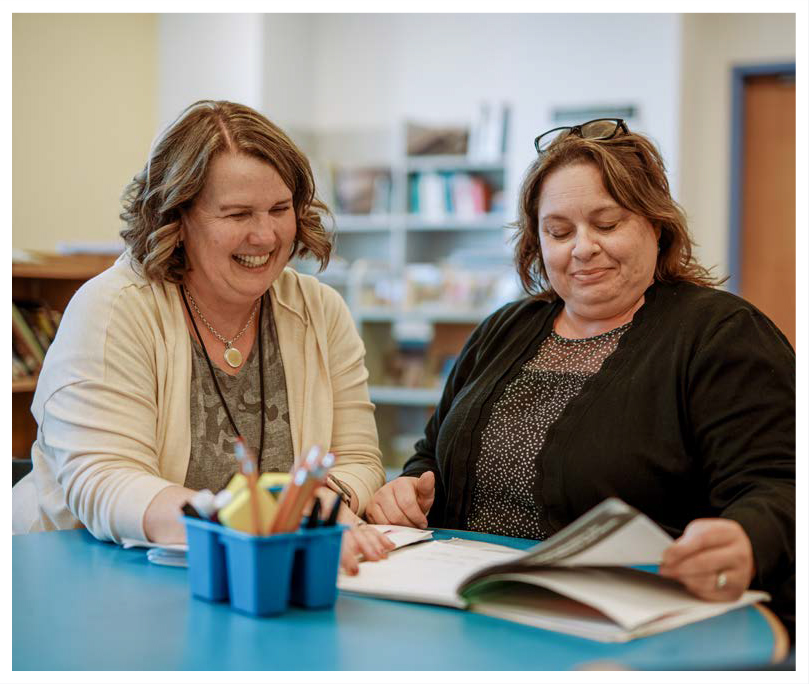Written by Catapult Learning, [email protected]
How implementing a holistic training program can build educator capacity and deliver better student outcomes
Today’s school administrators and educators face a daunting array of challenges. From increased pressure to improve test scores and bridge learning gaps exacerbated by the pandemic to complying with inclusion mandates and boosting educator retention rates. On the best of days, the work can feel overwhelming even for the most seasoned educators.

The need for an integrated approach to professional development.

Based on the myriad demands for their time and talents, educators and school leaders often turn to professional learning to help solve localized, one-off teaching and learning challenges. But to be truly effective—and to lay a foundation for sustainable school transformation—professional development must take a wider view and tackle core issues head-on. At Catapult Learning, we believe that optimal teaching and learning in classrooms and beyond, can take place only when these three critical areas are addressed in an integrated way:
- Eliminating non-academic hurdles
- Enhancing teaching excellence
- Cultivating leadership for meaningful change
Classroom Management to Unlock Learning
The classroom, a longstanding hub for learning, faces numerous non-academic obstacles that can hinder both student and educator success. Factors such as behavioral challenges, emotional disorders, and low student engagement directly affect learning. Without addressing these issues, other academic interventions may prove suboptimal. Rather than trying to address each obstacle individually, it is critical for educators to employ tested, integrated classroom management strategies.
Even before COVID-19 underscored the vital role schools play in holistic student support, 1 in 6 students had sufficient behavioral or emotional symptoms to be diagnosed with a childhood mental disorder.2
Post-COVID, 87% of schools say the pandemic has negatively impacted their students’ socio-emotional development.1 Further complicating things, educators today are also under greater pressure to serve students with special needs, as 66% of students with disabilities now spend more than 80% of their time in general education classrooms.4
These challenges are well known. Yet only 17% of general education teachers surveyed say they feel “very well prepared” to teach children with mild to moderate disabilities5—and 3 in 5 principals say inadequate training in classroom management hampers efforts to address student behavioral issues.6 As educators can attest, these issues often result in a challenging classroom environment. Not only is this bad for students—it also can have a negative impact on educator retention rates, with many teachers citing behavioral issues in the classroom as a major contributor to burnout.7
While these challenges are significant, proven classroom management strategies exist that can make a real difference today—and down the road. In many cases, educators may not even be aware of these strategies because their training was primarily based on curriculum and content rather than classroom management. With the right support, educators can uncover techniques and best practices for student engagement, proven methodologies to enhance executive function and resilience, and effective approaches to assisting students struggling with behavioral issues. Job-embedded coaching is a powerful tool that can help teachers implement these strategies in near real time—offering immediate support with day-to-day classroom challenges. For example, one behavioral strategy educators can easily embrace is to establish a clear set of routines and procedures and reinforce them regularly. Educating teachers on how to effectively manage their classrooms can lead to more positive, inclusive environments, where all students can learn—and where educators spend less time on discipline and more time on teaching.

Instructional Excellence for Academic Achievement
Subject-matter mastery is critical not only to students’ performance on standardized tests but also to their long-term academic success. The latest NAEP results show historic declines in math and reading scores—in some cases wiping out a generation’s worth of progress.8 Among 13-year-olds, for example, the NAEP long-term trend (LTT) for reading and mathematics assessments show performance declines of 7 points and 14 points, respectively, when compared to scores a decade ago.3
In this inflection point for schools across the country, it’s critical that educators are empowered to teach more effectively. One of the most meaningful ways to improve educator efficacy is to embrace an approach that is both broadly applicable and curriculum-independent. Professional development that focuses too heavily on specific textbooks, learning platforms, and other teaching resources may be less beneficial for educators in schools with unique needs—and fail to future-proof professional development work against curriculum changes. Curriculum-centric professional development also places undue emphasis on increasing content knowledge while neglecting the far more effective strategy of focusing on subject-specific instructional practices.9
The good news is that there are demonstrated ways to foster excellence in teaching ELA, literacy and writing, math and STEAM subjects—decoupled from any particular curriculum or platform. In addition to training and job-embedded coaching in specific subjects, educators should receive instruction in methodologies targeted at struggling students, such as MTSS, and in innovative ways to use assessments to better support student learning.
This approach to professional development is, first and foremost, beneficial for students. There is also evidence that it significantly improves educator retention efforts: Research indicates that educators who receive targeted instructional coaching in a given subject are significantly more likely to continue teaching that subject the following year.10
Leadership for Positive Impact

Strong and supportive leadership is key to success at the school and student level, making it a vital component of any professional development strategy. Effective leadership also enhances educator satisfaction and retention. One recent survey found that only 14% of educators strongly agreed that they had a clear understanding of how to reach their career goals.2 Without a well-defined track into leadership, there is significant risk that educators will feel as though they have no possibility of professional advancement—and may even leave the field altogether.
In the context of education, leadership development means establishing an achievement-oriented culture in schools—and building effective teams for mutual support and mentoring. It also involves creating and implementing change management strategies so that educators have a stable and nurturing work environment no matter what is happening at a school, district, or state level.
Integrating leadership development into a holistic professional development strategy equips educators with a streamlined pathway to career success and fulfillment. Prioritizing leadership in professional development not only enhances teachers’ effectiveness in their current roles but also arms them with the skills vital for career progression.
The path forward
Adopting a balanced, holistic approach to professional development that encompasses classroom management, instructional excellence and leadership development empowers educators to meet and overcome the diverse challenges they face. This integrated approach fortifies learning environments and offers vital support for educators, providing a robust and efficacious pathway to enhanced student outcomes and comprehensive school transformation.

About Catapult Learning
Catapult Learning provides education solutions that generate demonstrable academic achievement and better life outcomes for students, regardless of the learning obstacles or other challenges they face. Our team of more than 5,000 educators and 250+ coaches works to achieve sustained academic gains and build teacher and leadership capacity through job-embedded coaching, impactful workshops and institutes, and our resource-rich, on-demand learning platform, PDNow. Operating 190+ day schools and in-district classrooms that focus on behavioral support—and serving over 150,000 students and 25,000 educators annually—Catapult Learning is unmatched in its ability to implement professional development at scale and deliver consistent, high-quality professional learning in a variety of flexible formats.
1 https://nces.ed.gov/whatsnew/press_releases/07_06_2022.asp
2 https://www.nais.org/learn/independent-ideas/october-2022/teacher-retention-a-teachers-perspective-on-keeping-colleagues/
3 https://www.nationsreportcard.gov/highlights/ltt/2023/
4 https://nces.ed.gov/fastfacts/display.asp?id=59
5 https://www.ncld.org/wp-content/uploads/2019/05/Forward-Together_NCLD-report.pdf
6 https://www.brookings.edu/blog/brown-center-chalkboard/2023/06/08/survey-principals-say-they-need-better-trained-teachersand-more-resources-to-address-student-misbehavior/
7 https://sanjosespotlight.com/silicon-valley-santa-clara-county-san-jose-teachers-educators-burned-out-by-unruly-student-behavior/ or UCLA study primary source at https://transformschools.ucla.edu/wp-content/uploads/2022/10/Voices-from-the-ClassroomDeveloping-a-Strategy-for-Teacher-Retention-and-Recruitment.pdf
8 https://www.the74million.org/article/nations-report-card-two-decades-of-growth-wiped-out-by-two-years-of-pandemic/
9 https://annenberg.brown.edu/sites/default/files/rppl-building-better-pl.pdf
10 https://journals.sagepub.com/doi/10.3102/0002831220916840

